The best place to start is a definition, right?
In the digital marketing universe, Market Intelligence is a strategy that makes use of internal and external data to improve a brand’s performance.
This involves aspects such as upgrading products according to consumers’ expectations and ensuring competitiveness in the market.
Generally speaking, third-party data is great for this strategy, because it allows businesses to advertise to users all over the internet.
But, as you probably know, this type of data is slowly dying and companies can’t bet on it anymore.
On the counter side, Market Intelligence practices have been seen as the ultimate savior of data strategies.
So, in this super-post, we will take an in-depth look at the definition of Market Intelligence — its advantages and variations.
We will also walk you through some pro-tips on how to retire third-party data strategies for good, and rely entirely on organic and hyper-personalized approaches.
Read on!
- 1. What is Market Intelligence and Why Do You Need It?
- 2. What are the Main Types of Market Intelligence?
- 3. A Market Intelligence Strategy Always Start With This
- 4. How to Monitor Data for Your Business
- 5. How Important is Analyzing Conversion Rates in a Market Intelligence Strategy?
- 6. Putting your Market Intelligence to Work: How to add up SEO best-practices to your strategy?
- 7. Goodbye, Third-party Data: Adding Interactivity to Your Content Strategy
- 8. Top Tools For Your First-party Data Strategy
- 9. Wrap Up: Interactive Content as the Fuel for your Market Intelligence Strategy
1. What is Market Intelligence and Why Do You Need It?
As previously mentioned, Market Intelligence is an approach that aims to develop a business strategy guided by the collection and analysis of data.
Its current relevance is immeasurable, but it’s important to keep in mind that it’s a business practice that has been around for years.
The term was first used in the 1950s by Hans Peter Luhn, a US-based German researcher.
Hans published the article “A Business Intelligence System”, outlining relatively advanced concepts for the time, including automated data capture systems.
There is no indication that Luhn was attempting to improve the competitive performance of companies: his objective was to help scientists understand how to manage the rapid development of post-war technology.
However, his concepts began to be used by large and small companies alike, achieving general acceptance in the 1980s.
Naturally, market intelligence processes are continuing to change with the transformation of digital technologies.
However, independent of the means and objectives, the ultimate goal remains the same: to make it possible to collect and analyze data to improve strategic decisions.
2. What are the Main Types of Market Intelligence?
As you have seen, Market Intelligence covers a variety of areas and leads to benefits when applied to your strategic planning.
By focusing on the different approaches and their objectives, we can see 4 types of Market Intelligence.
Competitive intelligence
Market Intelligence default emphasizes products and services offered in a specific production niche.
The idea is to observe the behavior of consumers and competitors and establish strategic actions based on them.
In a way, it is a more reactive approach, which responds according to market trends.
Strategic intelligence
This approach looks for information to describe the business environment more comprehensively.
The intention is to create solid strategies based on a broad range of internal and external data.
Predictive intelligence
Here, the difference lies in a deeper focus on understanding the market.
Predictive intelligence monitors devices and subjects that are of interest to an organization, to anticipate the likelihood of relevant issues, such as threats or opportunities.
Data intelligence
Data intelligence aims to organize information and integrate it with software systems.
In this way, data will be analyzed and interpreted to aid in important brand decisions and actions.
To do this, it is important to have automated tools, such as Knewin’s data monitoring and analysis solutions.
3. A Market Intelligence Strategy Always Start With This
However impressive the reach of the internet, there’s no use in delivering your message to people with no interest in the product you have to offer.
Thus, the first step for any Market Intelligence strategy is to create one or more personas.
Buyer personas are semifictional characters, existing just between the imaginary and your reality.
Used to represent your ideal client, they have names, life stories, hobbies, motivations, and other elements to increase their visibility.
This process is not based on guesswork, but on studying and understanding your audience. In addition to more abstract characteristics, a persona must also present demographic data.
For example, it’s important to know the age group you hope to reach, as well as the geographic region, social class, gender, and whatever other categories you deem relevant.
Once created, this persona should be the foundation of your marketing and communication strategies.
Segmentation is present in virtually any of the best marketing practices today.
In an email marketing approach, for example, it’s critical to segment contacts according to where in the funnel they are or the specific type of solution you want to offer.
This way, your message becomes much more efficient, only reaching individuals who have a chance to reach the conversion point.
4. How to Monitor Data for Your Business
Data monitoring is essential for the success of Market Intelligence.
It involves planning, collecting, analyzing, and sharing data and information.
After gathering and evaluating references, a brand will define a plan for how to collect information, whether internal or external.
Collectors, collection points, and the key events to be analyzed also require the approval of the responsible stakeholders.
To ensure a smooth workflow, it’s always important to remember the necessity to maintain balance when organizing the phases of the Intelligence cycle.
There are 4 fundamental points that allow good data monitoring. We will address each below.
Team
However well you have structured your strategy, it won’t work without having the trained professionals to meet your company’s demands.
It is worth remembering that, although experts in data analysis and intelligence are essential for your strategy, professionals from other areas should also be involved.
Professionals from communication, marketing, and sales play an important role in the process, offering insights to adapt the data collection procedure according to the company’s focus and objectives.
It’s also necessary that the team responsible have efficient internal communication.
Feedback from salespeople, for example, is valuable for the marketing team to evaluate the effectiveness of campaigns.
In the end, working together is what keeps the data mapping process optimized on a consistent basis.
Practice
With the team properly trained, it’s time to put data monitoring into practice.
Naturally, the first step is to define the strategy, setting goals, identifying indicators, and assigning tasks to each of the professionals involved.
During this stage, you must also define which tools, processes, and information storage resources you will use.
For an initiative to be implemented successfully, it’s necessary to understand its relevance.
Any efforts need to be established within a culture focused on the proper use of information.
Analysis
Considered the key to your Market Intelligence strategy, any analysis can only occur after teams and objectives have been defined.
Depending on the nature and goals of the company, analysis can take place in a continuous manner or at specific intervals.
In addition, the analysis can either be performed manually or automated with technology.
Keep in mind that there is not a correct way to perform your analysis, since priorities and observations vary on a company-to-company basis.
However, employing technology streamlines the process and increases your team’s productivity.
In general, analyses aim to offer relevant insights on a company’s strategic performance, specifically how to develop marketing campaigns or new products.
Still, this process should focus on future goals and not past or present actions, which should simply serve as sources of information.
Technology
Finally, Market Intelligence won’t work without utilizing technology for at least some of the stages involved.
For example, digital tools are essential to effectively collect data on a large scale.
During analysis, technology can be used to quickly cross-check data and share them with the required departments automatically.
A creative approach to implementing technology allows for a variety of solutions to improve your data monitoring and make more accurate business decisions.
5. How Important is Analyzing Conversion Rates in a Market Intelligence Strategy?
Conversion refers to the moment when a lead or visitor takes an action your company desires.
This can range from clicks on an article to making a purchase in your online store.
The important thing to understand is that if you aren’t getting many conversions, you need to take steps to get your business on track.
After all, such a scenario indicates that your strategy isn’t meeting its objectives, which implies a huge waste of time, energy, and resources.
Therefore, every qualified marketing manager should keep an eye on variations in their conversion rate, to understand how to optimize business operations.
At the end of the day, the higher your conversion rate, the better your return on investment.
It’s important to emphasize at this point that monitoring must take into account all layers of your strategy.
It’s obviously important to calculate how many leads make a purchase, but it’s also essential to know the percentage of readers who react to your CTAs.
The good news is that this process is far simpler than you may expect.
To calculate your conversion rate, simply divide the number of conversions by the total number of individuals in question.
Then, to convert the result to a percentage, just multiply it by 100.
Let’s consider an example. Suppose you want to calculate the monthly conversion rate for a given landing page.
Using Analytics, you can see how many people accessed the page and the total number of people who filled out a form on it.
So, imagine the following numbers:
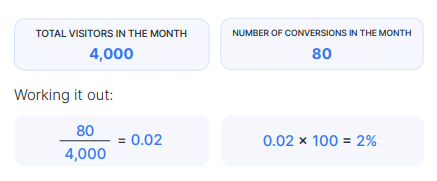
In this scenario, your conversion rate would be 2%.
While this example addresses a pretty straightforward scenario, you can use this formula to suit your business reality.
For example, many companies like to calculate the conversion rate for each stage of the funnel, to separately optimize each stage of the consumer journey.
To follow this tactic, just calculate how many visitors become leads, how many leads become opportunities, and so on.
6. Putting your Market Intelligence to Work: How to add up SEO best-practices to your strategy?
To achieve the organic traffic you’re looking for, the content published on your blog must be relevant to someone.
You already know that, but how do people find your content?
Like any marketing strategy, it all starts with planning:
- What are the results you hope to achieve through Search Engine Optimization (SEO)?
- Who are you trying to reach?
- How do you intend to get there?
This will pave the way to your strategy’s success.
Also, you should also know that an SEO strategy generally delivers results in the medium to long term.
Don’t expect the kind of immediate return which can come from ads and sponsored links.
However, SEO usually achieves a more sustainable return in the long term.
With that in mind, let’s take a look at the first steps of SEO.
Define objectives
The first step in creating your strategy is to define your objectives in optimizing your site, blog, or e-commerce.
To do this, you first have to know what SEO offers.
- Increasing organic traffic.
- Generate more leads.
- Create more sales.
- Reduce client acquisition cost (CAC).
- Educate the market.
- Increase brand authority.
Always seek to align these SEO objectives to your brand’s macro-objectives.
If your goal is to increase brand awareness, for example, SEO can help with this by placing your company’s site among the first positions on Google.
By setting objectives, you can also identify goals and KPIs.
If you’re looking for greater authority, for example, you can use metrics from Domain Authority and Page Authority.
Set the goals you hope to reach via these KPIs and when.
By doing so, while you execute your strategy and afterward, you can check these indicators to know if you’re on the right path to achieve your objective.
Define your buyer persona
You already know that, right? For a well-planned Market Intelligence strategy, you need to answer:
- After all, who is your strategy for?
- Who are you communicating with?
- Who are you bringing to your business?
Building your buyer personas should take into consideration the different demands a customer may have throughout the stages of the funnel.
This can be observed in the keywords used to search, more general at the top of the funnel, and becoming more specific towards the bottom.
Below, you will have a better idea of making the most of keywords.
Creating a killer keyword selection
A keyword search aims to identify the search terms that have the greatest potential for your strategy, according to search volume, conversion, and competitiveness.
It’s one of the key planning tools for SEO strategy and Content Marketing.
After all, it’s how you can identify optimization opportunities and set content creation priorities.
A keyword search usually starts with a list of terms related to your sector, product, and brand.
You can get ideas from Google Analytics and Google Search Console, or keyword tools, like SEMrush.
Afterward, this list needs to be organized.
You can separate the most used terms at each stage of the sales funnel and sort the list based on the greatest potential for your strategy.
Let’s say you’ve just launched a blog on your site and have identified the keyword that will direct the most traffic to it.
You can start with it and create a post optimized for this keyword to attract more visitors.
7. Goodbye, Third-party Data: Adding Interactivity to Your Content Strategy
We’ve promised you that we were going to cover this topic, right?
Third-party data used to be very important to Market Intelligence strategies that aim for the success of a brand.
But that’s not the reality anymore.
Improved methods of collecting data are being preferred by the top companies — and they have begun to approach users in a more natural way.
In this context, many brands realized that adopting an interactive content strategy is a question of survival in the digital age.
The tendency is for audiences to consume an increasing quantity of this type of content.
This generates valuable and accurate first-party data for business owners — basically, the kind of data you collect directly from your customers.
But what end goals can you achieve by using interactivity?
Engagement
The first and most obvious form to use interactive content is to generate engagement.
By encouraging consumers to participate in the experience, you guarantee engagement through content, whether answering questions on a quiz or filling out information on a landing page.
This becomes even more relevant in light of the current market scenario, characterized by challenges marketing professionals face in engaging their audience.
In a study conducted by Rock Content in partnership with Demand Metrics, 41% of participants admitted to not being able to create sufficiently engaging static content.
An intelligent use of interactivity builds an effective dialogue with your audience.
Over time, through encounters that consistently satisfy, people will be used to interacting with your content, leading to long-lasting relationships and value for both sides.
Measuring results and performing tests with your content are necessary in order to ensure an efficient approach that really boosts engagement.
For example, identifying which formats best perform best with your audience is key to the ongoing optimization of your strategy.
Employ A/B testing to choose among different models and use social media to validate your content.
One interesting suggestion is to post them somewhere like Twitter, where organic engagement is more common.
The best performers on these channels will likely be the most effective for your company.
Lead generation
You know how lead generation works, right?
After reaching and attracting visitors to your channels, you need them to see how your content is relevant to their needs, leading to repeat interactions.
Following their first contact, a visitor can already be considered a lead.
But be advised: keeping a user’s attention is becoming increasingly difficult.
Proof of this concept can be found in a study by Microsoft revealing that the average human attention span has decreased to a point where it’s currently less than that of a goldfish.
Achieving the engagement you require to generate leads is a challenge and then some.
And that’s where interactivity comes in.
Materials which promote a user’s interaction are far more efficient at retaining users.
They also have a greater chance than static content to be shared by internet users, which naturally improves its organic reach.
With that in mind, you simply need to understand how to create value for your visitors to turn them into leads.
Backlinks
Do you have a link building strategy?
Even if you don’t yet, you know that getting high-quality links to your content is extremely important for your company, right?
It’s one of the factors that build domain authority, resulting in higher search engine rankings.
But how to convince other sites to link to yours? One option is through partnerships, but you could opt for an even more organic path.
Creating resources that provide real value to a specific niche encourages blogs in those areas to recommend you to their readers.
For example, imagine your company is in tourism.
By creating an interactive tool to calculate expenses on a given trip, you’ve made your page extremely useful to a diverse audience who are searching for financial planning to travel.
Now, imagine that a well-known travel blog comes across your content and sees how it can offer value to its readers.
It’s quite likely that they will write a post about your calculator, resulting in more visitors to your age and strengthening your SEO strategy.
Educating consumers
We know that every Content Marketing strategy aims to generate and convert leads.
The first step can be achieved through the actions we’ve mentioned, like setting up an SEO strategy and maximizing your visitors’ engagement.
On the other hand, conversion can be a more involved process.
It’s necessary to map out the customer’s journey and identify the moment they are ready to be approached for a sale.
This doesn’t happen by chance.
To reach this point, your lead needs to be nurtured with information relevant to their pain and needs, awakening the idea to obtain a solution for them.
This process of educating your client can take place through a variety of channels, from email marketing campaigns to offering educational material.
In all cases, interactive content offers a playful way to share information with a user, resulting in both learning and engagement.
To illustrate, think of an interactive quiz that displays answers based on a visitor’s input, in addition to explanations of the feedback.
This is surely more attractive than just reading an article on the subject, wouldn’t you agree?
Most interesting of all is that this type of action can lead to other advantages for the company, as we’ll see in the next topic.
Collecting data
For any marketing initiative to succeed, an understanding of the persona’s characteristics is required, based on which stage of the sales funnel they are at.
After all, each stage of the buyer’s journey demands a specific type of content to nurture, in order to gradually win over consumers and lead them to conversions.
To achieve this insight, it’s essential that you develop an approach to collecting user data.
Interactive content adds to these efforts. Again, consider interactive quizzes.
Based on the results of your visitors, you can estimate their level of knowledge on the subject.
As a result, it becomes possible to determine whether the persona already has a strong enough foundation to advance to more in-depth materials or is still in the discovery phase, requiring more explanatory and comprehensive content to be nurtured.
And the best thing is that basically any type of information can be extracted through Interactive Marketing initiatives.
Landing pages, famous for exchanging valuable content for contact information, become much more effective when they evolve beyond static.
Infographics too. If the content is properly structured in an interactive way, you can easily see which parts generate the most engagement among your audience.
8. Top Tools For Your First-party Data Strategy
If you want to create a first-party data strategy, knowing these five tools is a great start.
Let’s get to it.
Ion
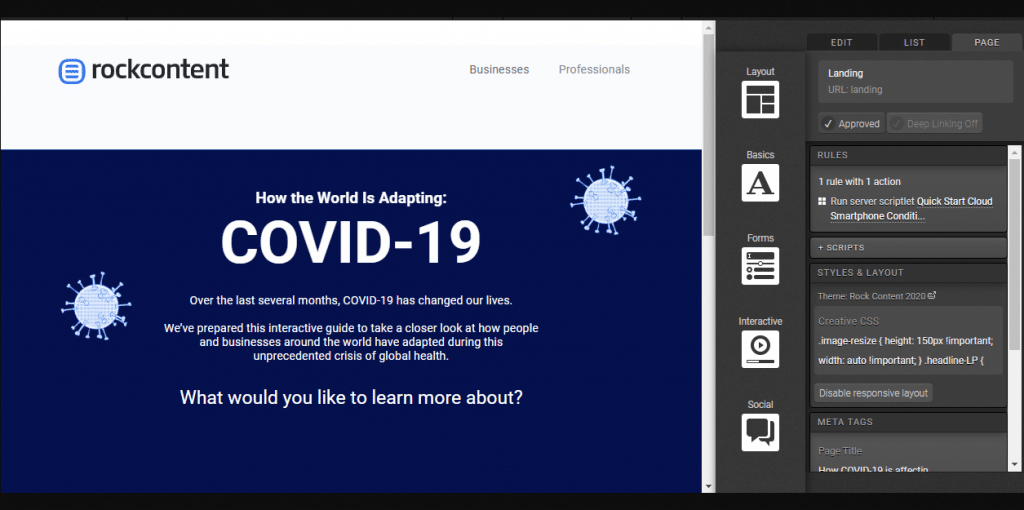
Do you remember how we emphasized the growing importance of Interactive Marketing, which adds elements of interactivity to content in order to increase consumer engagement?
Ion is a specialized platform for precisely this kind of production.
Without any knowledge of programming or coding, Ion makes it possible to create a variety of interactive content formats.
Users have the option to create their material from scratch or use the Quick Start tool, to produce and share content in less than an hour.
Templates can be easily edited through a very responsive and intuitive interface.
You can thus create material that reflects your brand’s visual identity and tone of voice, which is critical to a successful branding process, leading to increased conversions.
With Ion, it’s also easy and practical to perform multiple A/B tests, adding efficiency to your strategy.
Furthermore, the platform makes it easier to analyze campaigns, by generating reports that show exactly which consumers engage with your content.
This paves the way for you to optimize conversions. The data you have access to includes both external and first-party data.
Hello Bar
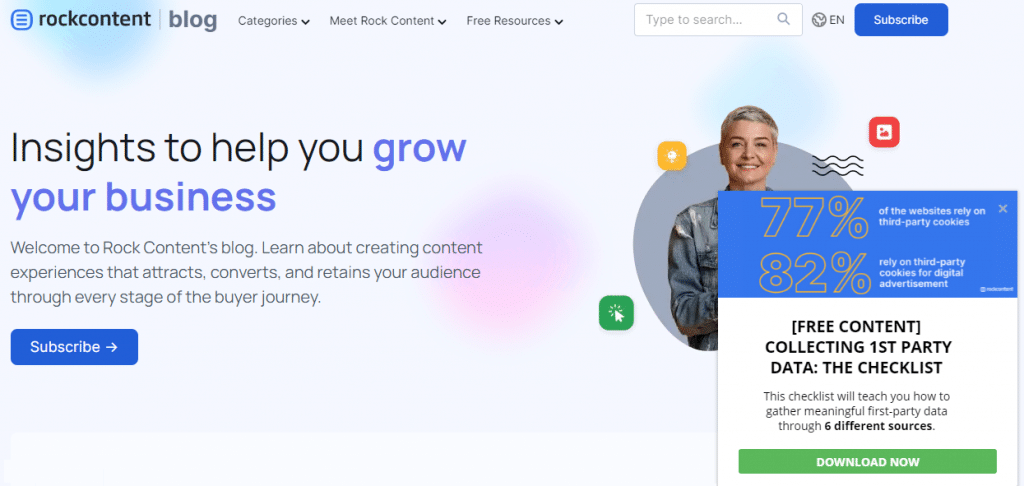
One of the most important conversions in the buyer’s journey takes place when the visitor goes from being a stranger to becoming a lead.
In other words, the moment when the person provides their contact details, allowing you to include them in your nutrition flow, for example, via email marketing.
To make this possible, it’s necessary to create a safe and attractive environment, so the persona feels comfortable sharing such information.
In a digital strategy, few resources are as effective to achieve this as Hello Bar.
This tool integrates with your website to display personalized pop-ups to your visitors.
You have the freedom to edit all elements, from CTA placement to the form items to the moment when they appear.
With a responsive and mobile-friendly design, this tool captures and presents user data, increasing your lead base.
One Signal

Push notifications are messages and alerts received on the home screens of your devices.
They deliver a user-focused message, with the goal of generating clicks and engagement with your website or app.
As mentioned above, there are two types of push notifications: via mobile and via the web.
Both are strategies that can be classified as Permission Marketing actions, and can improve the relationship with users who accepted this type of contact.
The alert can be sent automatically or manually, with a frequency that will vary according to the purpose of each message.
For example, if you have new content on your blog or have started a promotion in your e-commerce, the alert will be a way to notify you of this news as quickly as possible.
Continuing in the e-commerce segment, you can also take advantage of this strategy to remember about products abandoned in the cart, inform about the purchase delivery process and publicize the news that has just arrived in your virtual store.
Visually
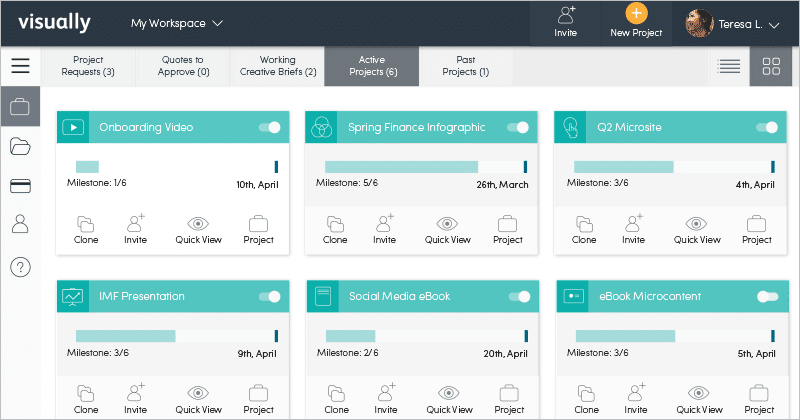
Visually makes it simple and affordable to create premium visual content for your marketing campaigns.
We’ve handpicked the best freelancers out there to help you produce high-impact infographics, videos, presentations, reports, ebooks, and interactive web microsites.
After we match you with world-class creative talent, our powerful collaboration platform streamlines the creative process and improves communication between you and your team of graphic designs, writers, and web developers.
The result is visual content creation that achieves your goals, while saving you time and money.
AnswerThePublic
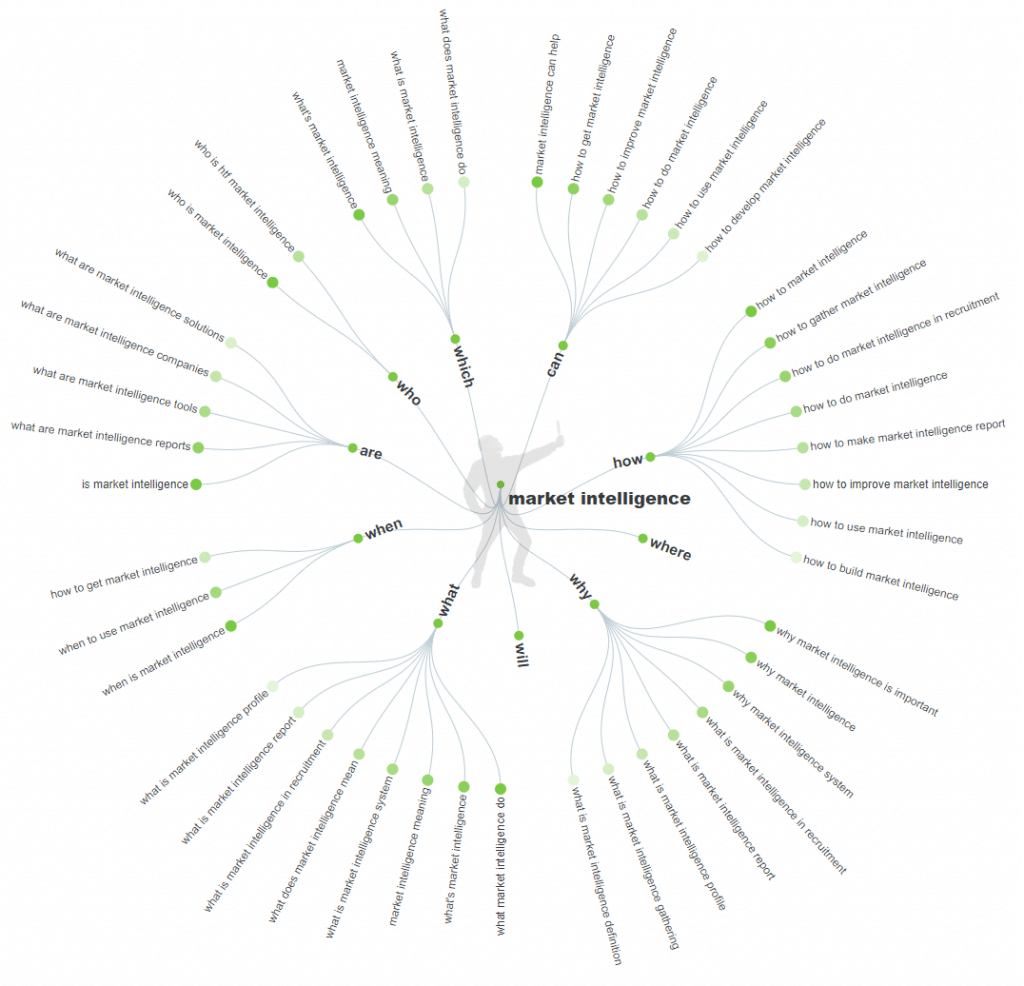
This free online tool helps you demonstrate to readers, and to the classifiers who work for search engines, that your content has the answers to users’ questions.
Automatically makes it a plausible option for a good browsing experience.
And that is what AnswerThePublic does for you: it finds the most common questions about a certain topic you look for.
The platform even creates propositional schemas, based on grammatical classes and other classifications.
9. Wrap Up: Interactive Content as the Fuel for your Market Intelligence Strategy
So, now you know a lot about Market Intelligence.
And, hopefully, you are really interested in interactive content as a reliable and effective option to collect data from users.
Considering this, why don’t you take a look at our very special ebook on how to replace boring content with engaging experiences?
It’s free and it will be a helpful guide to your interactive production!











